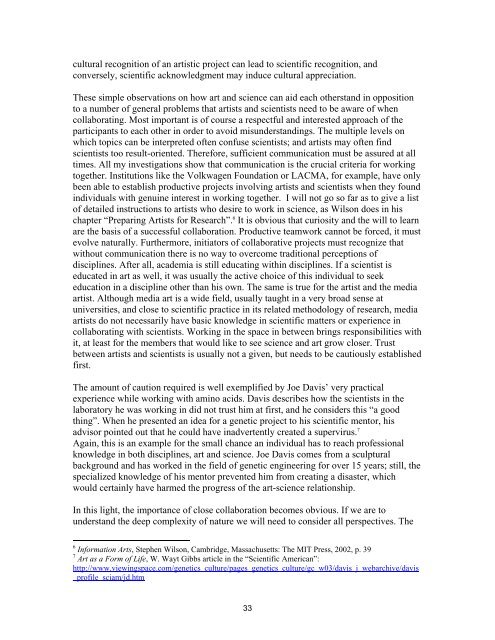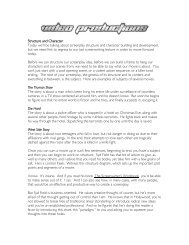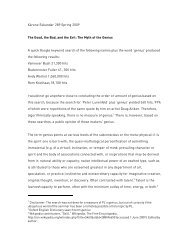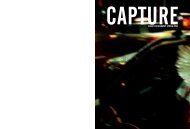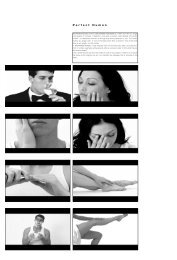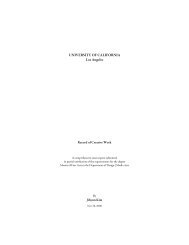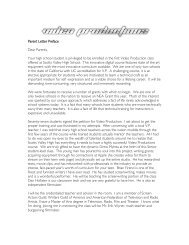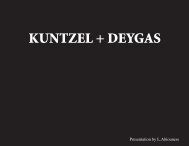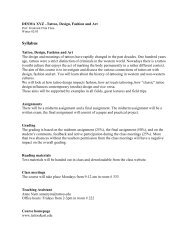Singing cells, art, science and the noise in between - Users - UCLA
Singing cells, art, science and the noise in between - Users - UCLA
Singing cells, art, science and the noise in between - Users - UCLA
Create successful ePaper yourself
Turn your PDF publications into a flip-book with our unique Google optimized e-Paper software.
cultural recognition of an <strong>art</strong>istic project can lead to scientific recognition, <strong>and</strong><br />
conversely, scientific acknowledgment may <strong>in</strong>duce cultural appreciation.<br />
These simple observations on how <strong>art</strong> <strong>and</strong> <strong>science</strong> can aid each o<strong>the</strong>rst<strong>and</strong> <strong>in</strong> opposition<br />
to a number of general problems that <strong>art</strong>ists <strong>and</strong> scientists need to be aware of when<br />
collaborat<strong>in</strong>g. Most important is of course a respectful <strong>and</strong> <strong>in</strong>terested approach of <strong>the</strong><br />
p<strong>art</strong>icipants to each o<strong>the</strong>r <strong>in</strong> order to avoid misunderst<strong>and</strong><strong>in</strong>gs. The multiple levels on<br />
which topics can be <strong>in</strong>terpreted often confuse scientists; <strong>and</strong> <strong>art</strong>ists may often f<strong>in</strong>d<br />
scientists too result-oriented. Therefore, sufficient communication must be assured at all<br />
times. All my <strong>in</strong>vestigations show that communication is <strong>the</strong> crucial criteria for work<strong>in</strong>g<br />
toge<strong>the</strong>r. Institutions like <strong>the</strong> Volkwagen Foundation or LACMA, for example, have only<br />
been able to establish productive projects <strong>in</strong>volv<strong>in</strong>g <strong>art</strong>ists <strong>and</strong> scientists when <strong>the</strong>y found<br />
<strong>in</strong>dividuals with genu<strong>in</strong>e <strong>in</strong>terest <strong>in</strong> work<strong>in</strong>g toge<strong>the</strong>r. I will not go so far as to give a list<br />
of detailed <strong>in</strong>structions to <strong>art</strong>ists who desire to work <strong>in</strong> <strong>science</strong>, as Wilson does <strong>in</strong> his<br />
chapter “Prepar<strong>in</strong>g Artists for Research”. 6 It is obvious that curiosity <strong>and</strong> <strong>the</strong> will to learn<br />
are <strong>the</strong> basis of a successful collaboration. Productive teamwork cannot be forced, it must<br />
evolve naturally. Fur<strong>the</strong>rmore, <strong>in</strong>itiators of collaborative projects must recognize that<br />
without communication <strong>the</strong>re is no way to overcome traditional perceptions of<br />
discipl<strong>in</strong>es. After all, academia is still educat<strong>in</strong>g with<strong>in</strong> discipl<strong>in</strong>es. If a scientist is<br />
educated <strong>in</strong> <strong>art</strong> as well, it was usually <strong>the</strong> active choice of this <strong>in</strong>dividual to seek<br />
education <strong>in</strong> a discipl<strong>in</strong>e o<strong>the</strong>r than his own. The same is true for <strong>the</strong> <strong>art</strong>ist <strong>and</strong> <strong>the</strong> media<br />
<strong>art</strong>ist. Although media <strong>art</strong> is a wide field, usually taught <strong>in</strong> a very broad sense at<br />
universities, <strong>and</strong> close to scientific practice <strong>in</strong> its related methodology of research, media<br />
<strong>art</strong>ists do not necessarily have basic knowledge <strong>in</strong> scientific matters or experience <strong>in</strong><br />
collaborat<strong>in</strong>g with scientists. Work<strong>in</strong>g <strong>in</strong> <strong>the</strong> space <strong>in</strong> <strong>between</strong> br<strong>in</strong>gs responsibilities with<br />
it, at least for <strong>the</strong> members that would like to see <strong>science</strong> <strong>and</strong> <strong>art</strong> grow closer. Trust<br />
<strong>between</strong> <strong>art</strong>ists <strong>and</strong> scientists is usually not a given, but needs to be cautiously established<br />
first.<br />
The amount of caution required is well exemplified by Joe Davis’ very practical<br />
experience while work<strong>in</strong>g with am<strong>in</strong>o acids. Davis describes how <strong>the</strong> scientists <strong>in</strong> <strong>the</strong><br />
laboratory he was work<strong>in</strong>g <strong>in</strong> did not trust him at first, <strong>and</strong> he considers this “a good<br />
th<strong>in</strong>g”. When he presented an idea for a genetic project to his scientific mentor, his<br />
advisor po<strong>in</strong>ted out that he could have <strong>in</strong>advertently created a supervirus. 7<br />
Aga<strong>in</strong>, this is an example for <strong>the</strong> small chance an <strong>in</strong>dividual has to reach professional<br />
knowledge <strong>in</strong> both discipl<strong>in</strong>es, <strong>art</strong> <strong>and</strong> <strong>science</strong>. Joe Davis comes from a sculptural<br />
background <strong>and</strong> has worked <strong>in</strong> <strong>the</strong> field of genetic eng<strong>in</strong>eer<strong>in</strong>g for over 15 years; still, <strong>the</strong><br />
specialized knowledge of his mentor prevented him from creat<strong>in</strong>g a disaster, which<br />
would certa<strong>in</strong>ly have harmed <strong>the</strong> progress of <strong>the</strong> <strong>art</strong>-<strong>science</strong> relationship.<br />
In this light, <strong>the</strong> importance of close collaboration becomes obvious. If we are to<br />
underst<strong>and</strong> <strong>the</strong> deep complexity of nature we will need to consider all perspectives. The<br />
6 Information Arts, Stephen Wilson, Cambridge, Massachusetts: The MIT Press, 2002, p. 39<br />
7 Art as a Form of Life, W. Wayt Gibbs <strong>art</strong>icle <strong>in</strong> <strong>the</strong> “Scientific American”:<br />
http://www.view<strong>in</strong>gspace.com/genetics_culture/pages_genetics_culture/gc_w03/davis_j_webarchive/davis<br />
_profile_sciam/jd.htm<br />
33


